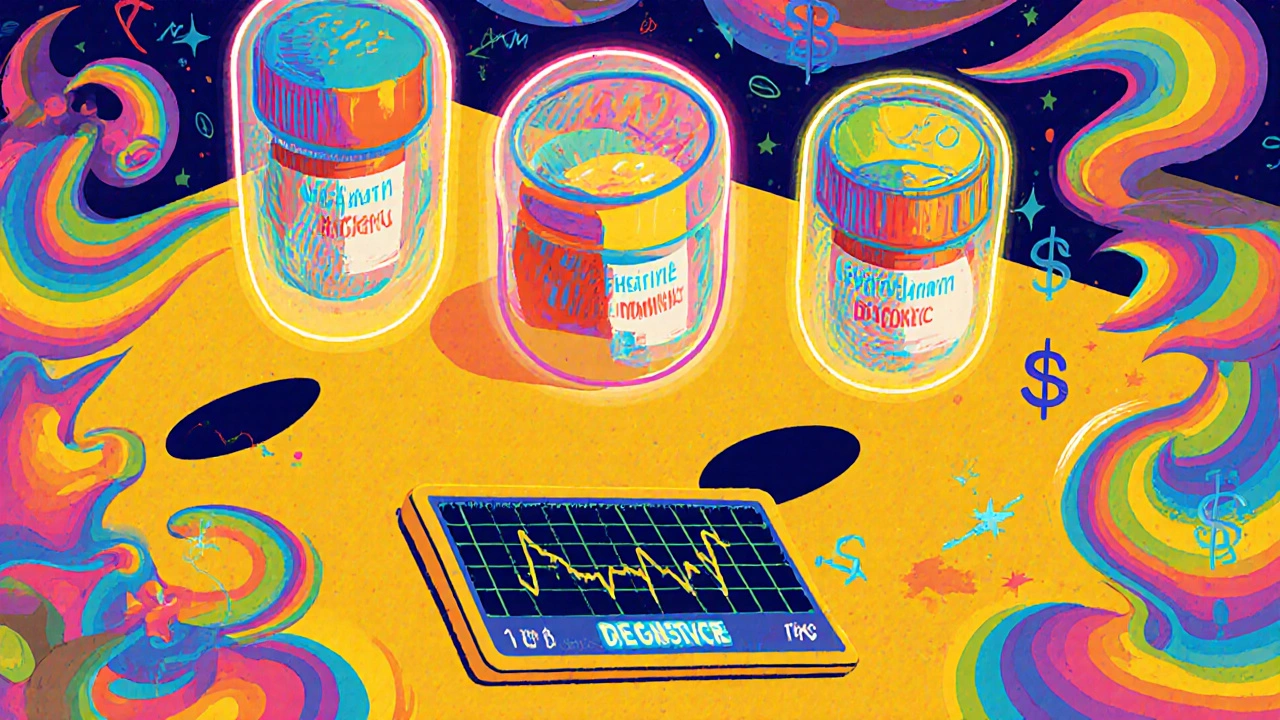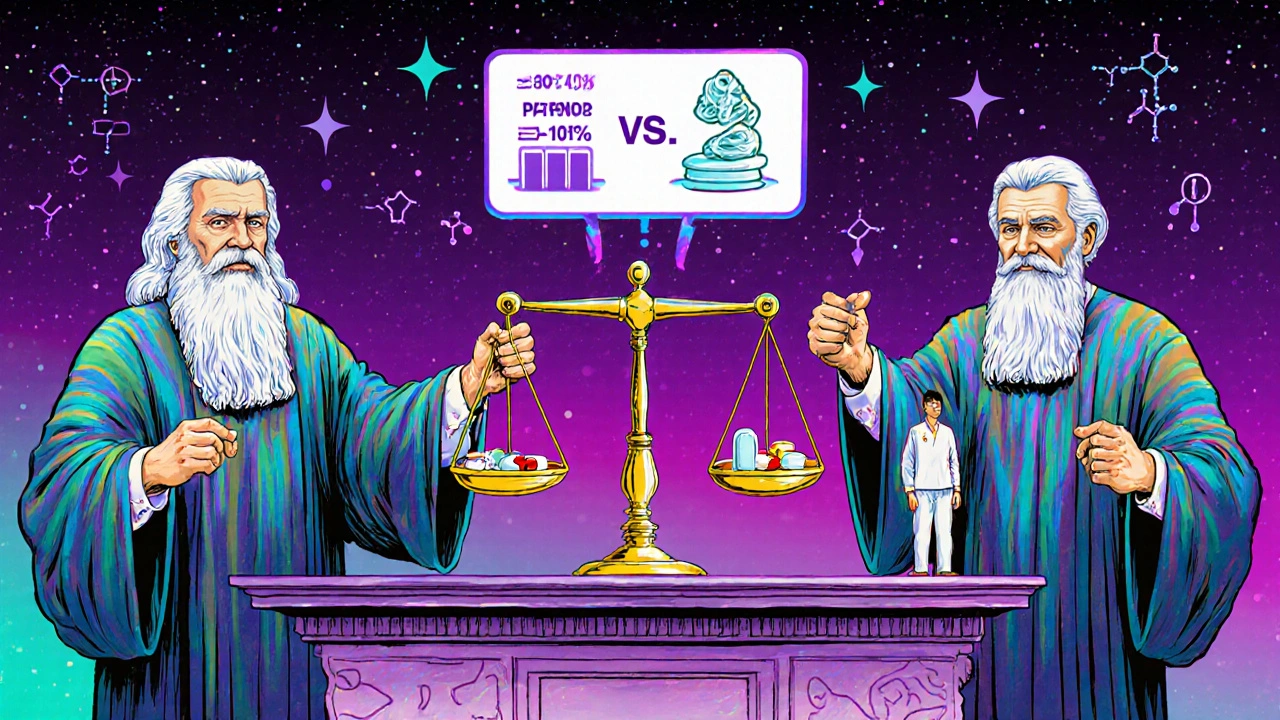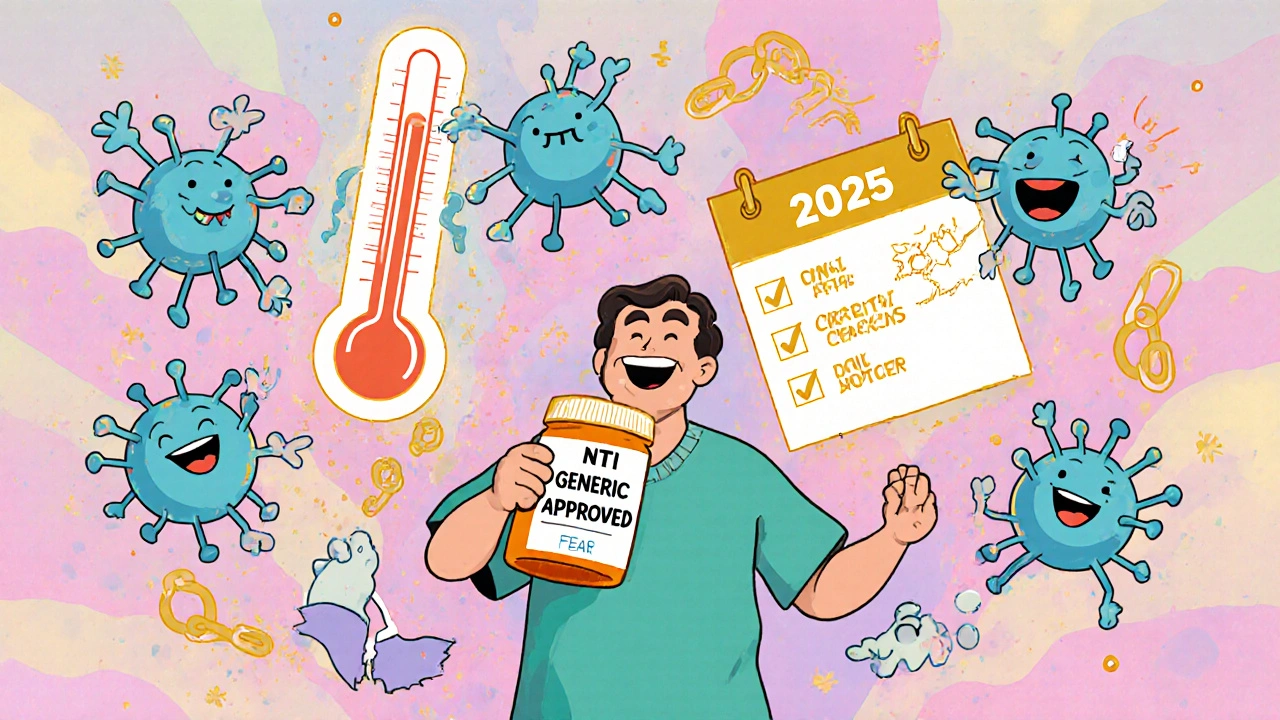Narrow Therapeutic Index Drugs: Stricter Bioequivalence Requirements Explained

When you take a medication like warfarin, levothyroxine, or digoxin, even a tiny change in how much of the drug enters your bloodstream can mean the difference between effective treatment and a life-threatening reaction. These are narrow therapeutic index drugs - medications where the gap between a safe dose and a dangerous one is razor-thin. That’s why regulators don’t treat them like ordinary generics. The rules for proving they work the same as the brand-name version are far stricter, and for good reason: patient safety is on the line.
What Makes a Drug a Narrow Therapeutic Index (NTI) Drug?
A drug is classified as having a narrow therapeutic index when its effective dose is very close to its toxic dose. The FDA defines this using a therapeutic index - the ratio between the dose that causes toxicity and the dose that produces the desired effect. If that ratio is 3 or lower, it’s considered NTI. For example, if 10 mg of a drug works well and 30 mg causes harm, the therapeutic index is 3. That’s the cutoff.
These aren’t obscure drugs. They’re widely used for critical conditions: heart rhythm control (digoxin), seizure management (phenytoin, carbamazepine), thyroid replacement (levothyroxine), organ transplant rejection (tacrolimus, sirolimus), and blood thinning (warfarin). Around 35 drugs fall into this category in the U.S., with combined annual sales of $45 billion. Millions of patients rely on them daily.
What makes NTI drugs different isn’t just the chemistry - it’s the risk. A 10% drop in blood levels might mean a seizure returns. A 10% spike might cause internal bleeding. There’s no room for error. That’s why switching from brand to generic - something routine for most medications - requires extra caution here.
Why Standard Bioequivalence Rules Aren’t Enough
For most generic drugs, regulators accept bioequivalence if the generic’s blood concentration falls within 80% to 125% of the brand-name drug. That’s called the 80-125% rule. It works fine for drugs where small differences don’t matter - like antibiotics or blood pressure pills.
But for NTI drugs, that range is too wide. Imagine two versions of warfarin: one gives you 95% of the brand’s concentration, another gives you 115%. Both pass the standard test. But 115% might push you into dangerous bleeding territory. That’s why regulators had to rethink the rules.
Starting in the 2010s, agencies began tightening requirements. The goal wasn’t to block generics - it was to make sure the generics that do get approved are truly interchangeable without risk. The result? A patchwork of new standards that vary by country.
How Different Regulators Handle NTI Bioequivalence
Not all agencies agree on how to fix the problem. Three major players - the FDA, EMA, and Health Canada - have each built their own approach.
The U.S. Food and Drug Administration (FDA) uses a complex, science-driven method called Reference-Scaled Average Bioequivalence (RSABE). It doesn’t just look at average blood levels. It also measures how much the drug’s concentration varies from person to person. If the brand drug has high variability, the FDA allows slightly wider limits - but only if the generic doesn’t vary more than the brand. Then, it adds a second test: the generic must still stay within the traditional 80-125% range. Finally, it checks that the generic’s variability isn’t more than 2.5 times the brand’s. This three-part test is the most rigorous in the world.
Meanwhile, the European Medicines Agency (EMA) takes a simpler route. It uses a fixed, tighter window: 90% to 111%. If a generic’s blood levels fall outside that range, it fails - no matter how consistent or variable the brand drug is. This approach is easier to apply but doesn’t account for how the brand drug behaves in real patients.
Health Canada uses a middle ground: 90.0% to 112.0% for the area under the curve (AUC), which measures total drug exposure over time. It’s stricter than the standard but less complex than the FDA’s method.
The FDA’s approach is more scientifically precise, especially for drugs with moderate variability. But it’s also harder and more expensive to test. A standard bioequivalence study might cost $300,000-$700,000. For an NTI drug, it can hit $500,000-$1 million because it needs more participants - often 36 to 54 people instead of 24 to 36 - and more complex study designs, like four-period crossover trials.

Real-World Evidence Supports Stricter Standards
Some critics argue that these tough rules slow down generic access and drive up prices. But real-world data tells a different story.
A 2017 study in the American Journal of Transplantation looked at kidney transplant patients switched from brand to generic tacrolimus. Using the FDA’s strict bioequivalence criteria, researchers found no increase in rejection rates or side effects. Another study in Circulation: Cardiovascular Quality and Outcomes tracked warfarin users over years. There was no difference in bleeding or clotting events between brand and generic versions - as long as the generic met the tighter bioequivalence standards.
These findings matter. They show that when generics meet the right criteria, they’re just as safe. The problem isn’t generics themselves - it’s poorly tested ones.
Why Generic NTI Drugs Still Face Hesitation
Despite the science, adoption of generic NTI drugs lags behind other generics. Only about 68% of NTI prescriptions are filled with generics, compared to 90% for non-NTI drugs. Why?
Prescribers worry. Patients worry. Even if the data says it’s safe, changing a medication you’ve been on for years feels risky. Some doctors still insist on brand-only prescriptions. Pharmacists may hesitate to substitute without explicit permission.
There’s also confusion. The FDA doesn’t publish a single, official list of NTI drugs. Instead, it issues guidance for each drug individually - warfarin here, levothyroxine there. That makes it hard for manufacturers to know what’s required. A company might spend millions developing a generic for a drug, only to find out the FDA’s requirements changed last year.
And cost is a barrier. With studies costing up to $1 million, many smaller generic companies avoid NTI drugs entirely. That reduces competition, which can keep prices higher than they should be.

What’s Changing in 2025?
Things are shifting. In 2022, the FDA published a pharmacometric approach to classify NTI drugs using quantitative thresholds - moving away from case-by-case decisions. That’s a big step toward consistency.
In 2023, the FDA announced plans to develop a formal, comprehensive list of NTI drugs based on therapeutic index calculations. That list is expected by late 2025. It will help manufacturers, prescribers, and pharmacists know exactly which drugs require stricter testing.
The FDA also plans to finalize its RSABE guidance for NTI drugs in Q2 2024. That will turn current draft rules into binding requirements.
Internationally, there’s talk of harmonization. The EMA, FDA, and Health Canada are discussing aligning their standards. If they can agree on a common framework - maybe a hybrid of fixed limits and variability scaling - it could cut development costs by 15-20%. That would mean more generic options, faster.
What This Means for Patients
For you, the patient, the takeaway is simple: generic NTI drugs can be safe - but only if they meet the right standards. Don’t assume all generics are equal. If your doctor prescribes a brand-name NTI drug, ask if there’s a generic that’s been approved under the stricter criteria.
Ask your pharmacist: "Is this generic approved under the FDA’s NTI bioequivalence guidelines?" If you’re on warfarin, levothyroxine, or tacrolimus, consistency matters. Stick with the same manufacturer if possible. Don’t switch brands unless your provider approves it.
And if you’re switching from brand to generic - monitor your symptoms. For drugs like warfarin, your INR levels need to be checked more often at first. For thyroid meds, watch for fatigue, weight changes, or heart palpitations. Report anything unusual.
The goal isn’t to scare you. It’s to empower you. These drugs save lives. And with the right testing, generics can too.
What drugs are considered narrow therapeutic index drugs?
Common NTI drugs include warfarin, levothyroxine, digoxin, phenytoin, carbamazepine, tacrolimus, sirolimus, lithium carbonate, theophylline, and valproic acid. These are used for conditions like blood clotting, thyroid disorders, seizures, and organ transplant rejection. The FDA doesn’t publish a full list but has issued specific bioequivalence guidance for 15 of these drugs as of 2023.
Why are bioequivalence requirements stricter for NTI drugs?
Because small changes in blood concentration can lead to serious side effects or treatment failure. For example, a 10% increase in warfarin levels can cause dangerous bleeding, while a 10% drop can lead to a stroke. Standard bioequivalence limits (80-125%) are too wide for these drugs. Tighter limits ensure the generic performs just as safely and effectively as the brand.
Does the FDA approve generic NTI drugs?
Yes, but only if they pass a stricter set of bioequivalence tests. The FDA requires three criteria: Reference-Scaled Average Bioequivalence (RSABE), a variability comparison (test drug variability ≤ 2.5× reference), and standard Average Bioequivalence (80-125%). Only generics meeting all three are approved. Several, including generic warfarin and tacrolimus, have been approved under these rules.
Are generic NTI drugs as safe as brand-name versions?
Studies show they are - when they meet the stricter bioequivalence standards. A 2017 study in transplant patients found no increase in rejection with generic tacrolimus. A 2019 study on warfarin found no difference in bleeding or clotting events between brand and approved generics. The key is regulatory approval under NTI-specific guidelines, not the brand name itself.
Why are generic NTI drugs more expensive than other generics?
Because the bioequivalence studies are more complex and costly. They require larger sample sizes (36-54 participants vs. 24-36), longer study periods, and more sophisticated analysis. Costs can reach $500,000-$1 million per drug, compared to $300,000-$700,000 for standard generics. Fewer companies are willing to invest, reducing competition and keeping prices higher.
Should I switch from brand to generic NTI drug?
Talk to your doctor first. If the generic is approved under the FDA’s NTI bioequivalence guidelines, it’s considered safe. But because these drugs are so sensitive, your provider may recommend sticking with the same manufacturer to avoid any potential variability. If you do switch, monitor for changes in symptoms or lab results (like INR for warfarin or TSH for levothyroxine) and report them immediately.
Shante Ajadeen
November 14, 2025 AT 08:12Man, I’ve been on levothyroxine for years and I swear, switching generics felt like playing Russian roulette. One brand made me feel like a zombie, the next had me up at 3 a.m. heart racing. When my pharmacist finally gave me the one labeled 'FDA NTI approved,' everything clicked. No more guessing. Just… normal.
Don’t let anyone tell you generics are all the same. For these meds, it’s not about cost-it’s about survival.
dace yates
November 14, 2025 AT 14:07I read the FDA’s RSABE guidance last week and honestly? My brain hurt. But then I looked up my tacrolimus prescription and saw it had passed all three tests. That’s when it hit me-this isn’t bureaucracy. It’s science protecting people like my dad after his transplant.
Why don’t more docs know this? Why do we still get handed brand names by default?
Danae Miley
November 15, 2025 AT 21:52Let’s be clear: the EMA’s 90–111% rule is lazy. It ignores variability, which is the entire point of NTI drugs. The FDA’s approach isn’t perfect, but it’s the only one that accounts for real-world pharmacokinetics. Health Canada’s compromise? Still better than nothing, but it’s not science-it’s policy theater.
If you’re a manufacturer trying to cut corners on bioequivalence studies, you’re not saving money-you’re risking lives. And if regulators aren’t enforcing this rigorously, they’re failing their mandate.
Charles Lewis
November 15, 2025 AT 22:24It is imperative that we recognize the profound implications of these regulatory distinctions, particularly as they pertain to patient safety and equitable access to life-sustaining medications. The current paradigm, while scientifically sophisticated in its application by the FDA, inadvertently creates systemic barriers for smaller pharmaceutical entities, thereby reducing market competition and, paradoxically, potentially inflating long-term costs for consumers.
Furthermore, the absence of a centralized, publicly accessible list of NTI drugs introduces unnecessary confusion among prescribers and pharmacists alike, undermining the very goal of standardization. A unified, transparent classification system-not only for the United States but internationally-is not merely desirable; it is an ethical imperative in modern pharmacovigilance.
Renee Ruth
November 16, 2025 AT 05:57Oh please. They’re just using ‘patient safety’ as a cover to protect Big Pharma’s profits. Why do you think the FDA takes 3 years to approve a generic for warfarin? Because the brand still makes $200M a year off it. The ‘strict standards’? A smokescreen.
And don’t get me started on how they charge $1M for a study-somebody’s getting rich off this ‘science.’ Real patients? They’re the ones stuck paying $500 a month for a pill that’s chemically identical.
Wake up. This isn’t about safety. It’s about control.
Samantha Wade
November 17, 2025 AT 20:21To everyone saying this is just corporate greed: I’ve worked in hospital pharmacy for 18 years. I’ve seen patients crash because a generic wasn’t properly tested. I’ve seen INR levels spike overnight because someone switched to a cheaper version that didn’t meet NTI standards.
The FDA’s rules are hard-but they’re right. And yes, they’re expensive. But $1 million per study is nothing compared to the cost of a transplant rejection or a hemorrhagic stroke.
Let’s not pretend this is about profit. It’s about keeping people alive. And if that means we need to invest more in testing, then we should. Every single time.
Also: if your doctor won’t prescribe the FDA-approved generic, ask why. If they don’t know the difference, they need to catch up.
Elizabeth Buján
November 17, 2025 AT 23:20bro i just found out my lil cousin’s on digoxin and her mom was switching to the cheap generic every time… like, i didn’t even know this stuff existed until i read this. now i’m telling everyone i know who’s on thyroid meds or blood thinners to check the label.
it’s wild how something so small-like which pill you get-can make you feel like a whole different person. i’m glad someone’s fighting for this. thank you for writing this.
also i’m gonna print this out and give it to my aunt. she thinks ‘generic = bad’ and i need her to know it’s not that simple.
Andrew Forthmuller
November 18, 2025 AT 05:27NTI drugs = no cap. stick to one brand. period.